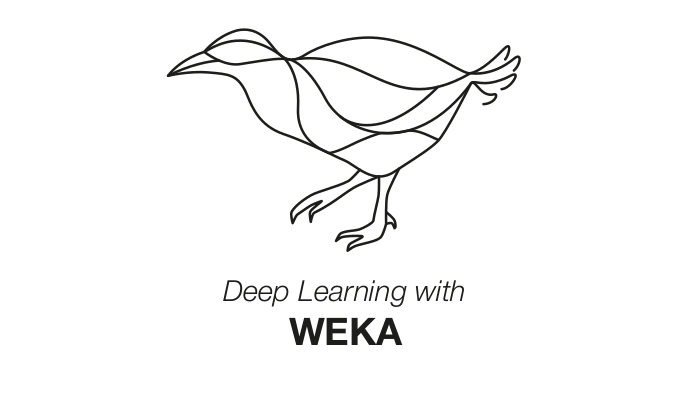WekaDeeplearning4j gives users the ability to train and test deep learning models from within the Weka environment. Our goal is to make deep learning available to users with zero knowledge of programming. The package uses Deeplearning4j as backend. Weka, and therefore also the WekaDeeplearning4j package, can be accessed via various interfaces. While the main focus of this package is the Weka GUI for users with no programming experience, it is also possible to access the presented features via the Weka commandline line runner as well as from the Weka Java API. Check out the getting-started tutorials for more information.
The full documentation, giving installation instructions and getting started guides, is available here.
The package can be installed via the Weka Package Manager GUI.
Alternatively, the latest release on GitHub provides the zip file of the package that allow easy installation via the commandline:
java -cp weka.jar weka.core.WekaPackageManager \
-install-package package.zipTo add GPU support, download and run the latest install-cuda-libs.sh for Linux/Macosx or install-cuda-libs.ps1 for Windows. Make sure CUDA is installed on your system as explained here.
The install script automatically downloads the libraries and copies them into your wekaDeeplearning4j package installation. If you want to download the library zip yourself, choose the appropriate combination of your platform and CUDA version from the latest release and point the installation script to the file, e.g.:
./install-cuda.sh ~/Downloads/wekaDeeplearning4j-cuda-10.2-1.60-linux-x86_64.zipAs most of Weka, WekaDeeplearning4j's functionality is accessible in three ways:
- Using the Weka workbench GUI
- Programming with Weka in Java
- Via the commandline interface
All three ways are explained in the getting-started documentation.
Example commandline scripts are provided in the weka-run-test-scripts directory, e.g. a simple network with one dense layer of 32 neurons and one output layer, classifying the iris dataset, would look like the following:
$ java weka.Run \
.Dl4jMlpClassifier \
-layer "weka.dl4j.layers.DenseLayer -nOut 32 -activation \"weka.dl4j.activations.ActivationReLU \" " \
-layer "weka.dl4j.layers.OutputLayer -activation \"weka.dl4j.activations.ActivationSoftmax \" " \
-numEpochs 30 \
-t datasets/nominal/iris.arffwhich results in:
=== Stratified cross-validation ===
Correctly Classified Instances 141 94 %
Incorrectly Classified Instances 9 6 %
Kappa statistic 0.91
Mean absolute error 0.0842
Root mean squared error 0.1912
Relative absolute error 18.9359 %
Root relative squared error 40.5586 %
Total Number of Instances 150
=== Detailed Accuracy By Class ===
TP Rate FP Rate Precision Recall F-Measure MCC ROC Area PRC Area Class
1.000 0.000 1.000 1.000 1.000 1.000 1.000 1.000 Iris-setosa
0.880 0.030 0.936 0.880 0.907 0.864 0.978 0.928 Iris-versicolor
0.940 0.060 0.887 0.940 0.913 0.868 0.979 0.972 Iris-virginica
Weighted Avg. 0.940 0.030 0.941 0.940 0.940 0.911 0.986 0.967
=== Confusion Matrix ===
a b c <-- classified as
50 0 0 | a = Iris-setosa
0 44 6 | b = Iris-versicolor
0 3 47 | c = Iris-virginica
The same setup can be achieved in Java with the following code:
// Setup layers
DenseLayer dense = new DenseLayer();
dense.setNOut(32);
OutputLayer out = new OutputLayer();
// Setup MLP
Dl4jMlpClassifier mlp = new Dl4jMlpClassifier();
mlp.setLayers(dense, out);
// Build model
mlp.buildClassifier(loadIris());The full documentation, giving installation instructions and getting started guides, is available at https://deeplearning.cms.waikato.ac.nz/.
The java documentation can be found here.
If you want to contribute to the project, check out the contributing guide.
Check out DEVELOPMENT.md for further information.
Please cite the following paper if using this package in an academic publication:
S. Lang, F. Bravo-Marquez, C. Beckham, M. Hall, and E. Frank WekaDeeplearning4j: a Deep Learning Package for Weka based on DeepLearning4j, In Knowledge-Based Systems, Volume 178, 15 August 2019, Pages 48-50. DOI: 10.1016/j.knosys.2019.04.013 (author version)
BibTex:
@article{lang2019wekadeeplearning4j,
title={WekaDeeplearning4j: A deep learning package for Weka based on Deeplearning4j},
author={Lang, Steven and Bravo-Marquez, Felipe and Beckham, Christopher and Hall, Mark and Frank, Eibe},
journal={Knowledge-Based Systems},
volume = "178",
pages = "48 - 50",
year = "2019",
issn = "0950-7051",
doi = "https://doi.org/10.1016/j.knosys.2019.04.013",
url = "http://www.sciencedirect.com/science/article/pii/S0950705119301789",
publisher={Elsevier}
}
Original code by Mark Hall




